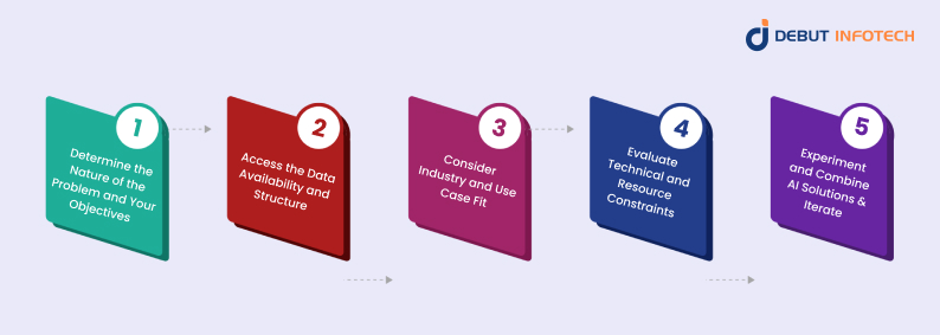Struggling to make a choice in the GenAI vs predictive-AI debate?
Most business executives are, too!
Recent generative AI trends have prompted various businesses and executives to struggle to decide when to use GenAI versus predictive AI.
In this article, we take a closer look at the major decision-making factors.
Here are some of our findings:
TL;DR:
- Generative AI helps to produce new content, while predictive AI forecasts future events.
- Machine learning and deep learning are subsets of predictive AI
- The nature of the problem determines the best choice. Therefore, GenAI is best for solving creation problems, while predictive AI is best for classification and regression problems.
- GenAI requires more computational power than predictive AI.
- Factors to consider when choosing between GenAI vs predictive-ai include the nature of the problem, data structure, industry use cases, and computational resource requirements.
Without further ado, let’s get into it.
What is Gen AI?
As the name implies, generative AI is a special type of AI capable of generating new content. Gen AI can generate coherent texts, software code, realistic images, music notations, chemical formulas- you name it!
But how?
Like predictive AI techniques like machine learning and deep learning, Gen AI analyzes vast amounts of data using different machine learning models. In fact, it is built on a breakthrough deep learning architecture known as transformers.
Some of these models include the following:
- Foundation Models (FM): These are ML models trained on a broad spectrum of unlabeled and generalized data. As such, they can perform a wide variety of general tasks by using learned patterns and relationships to predict the next term in a sequence.
- Large Language Models (LLMs): These are a class of FMs specifically focused on language-related tasks like text generation, summarization, open-ended conversations, or information extraction.
What is Predictive AI?
Predictive AI is a type of artificial intelligence that uses statistical analysis and machine learning to identify patterns and forecast future behaviors or occurrences. It helps businesses, individuals, and organizations make decisions based on historical data and current information.
Some of its most popular applications include:
- Anticipating financial market trends using predictive analytics
- Scheduling equipment maintenance
- Anomaly detection
- Sales and demand forecasting
The key takeaway here is that predictive AI is a specialized form of artificial intelligence that uses complex algorithms to make near-accurate predictions.
It contrasts sharply with Gen AI, which uses complex algorithms for generating new content.
As such, we can say predictive AI has two major subsets, namely:
- Machine learning
- Deep learning.
Let’s talk briefly about these two below.
What is Machine Learning?
Machine learning is a type of artificial intelligence (AI) that uses statistical and computational techniques to identify patterns in a given dataset and make predictions or decisions based on these patterns without being explicitly programmed to do so.
Machine Learning (ML) is mostly used to handle tabular/structured data presented in rows and columns. In fact, using machine learning to handle tasks involving unstructured data (i.e., data that isn’t presented in rows and columns) requires manually structuring the data, and this can be an expensive process.
As such, businesses use ML to handle some use cases involving structured data. Some of them include the following:
- Forecasting product demand and inventory needs based on historical data
- Customer churn prediction and prevention
- Predicting the risks of loan defaults
Taking a closer look at some of the use cases highlighted above, you’ll notice that they are all problems that allow ML algorithms to study the patterns in historical data presented in rows and columns (tabular or structured data).
What is Deep Learning?
Deep Learning (DL) is a subset of machine learning that uses artificial neural networks to process both structured and unstructured data without the need for upfront manual data structuring.
Spot the difference?
DL is essentially a type of ML because it identifies patterns in a given dataset and makes predictions based on these patterns without being explicitly programmed to do so.
However, it is a bit more advanced than ML because it uses artificial neural networks instead of statistical and computational techniques. As such, it can process unstructured data like images, audio, and natural language—a task that machine learning cannot attempt without manual structuring. In fact, it is capable of making non-linear, complex correlations within datasets.
Because of its greater processing power, DL requires more training data and computational resources than machine learning.
So, when do we use each of these algorithms?
Let’s find out in the following sections
GenAI vs Predictive-AI: How to Choose the Right Approach

Both predictive AI and generative AI are technology solutions built to solve problems. However, their nature, strengths, and weaknesses make each of them best suited for different purposes.
1. Determine the Nature of the Problem and Your Objectives
You need to think about predictive AI and generative AI as both tools or means to an end. Rather than obsessing about which new shiny technology you’re going to be deploying in your business, you need to understand the problem you’re trying to solve fully.
Next, you can then apply your understanding of the technologies (as we have provided above) to solving the problems.
In simple words, find the technology whose characteristics align with your problem best.
So, what does this look like in practice?
The problems you’re trying to solve can be broadly classified into two main groups:
- Generation problems: Problems where the goal is to create new original content. In these situations, your desired output is usually unstructured. For example, they could be texts, images, sounds, or videos.
- Prediction problems: These are problems where the goal is to forecast future outcomes, classify data points, or identify patterns that inform decision-making. As such, prediction problems can be further classified as follows:
- Classification problems: Problems where the goal is to categorize data points into predefined categories. E.g., identifying spam emails or categorizing cells as diseased or not.
- Regression Problems: Problems where the goal is to predict continuous numerical values based on input data. E.g., using predictive analytics to schedule equipment maintenance.
Once you’re able to identify what type of problem you want to solve accurately, it becomes easy to select the best AI approach. The table below is a quick guide for your decision-making process.

This isn’t an exhaustive table, but it’s a good starting point.
2. Access the Data Availability and Structure
You should be asking yourself two questions at this point, namely:
- Is the available data structured or unstructured?
- Do we have enough data?
As we have highlighted earlier, machine learning algorithms are better suited for handling problems involving structured data presented in a tabular form.
On the other hand, problems involving unstructured data like text or images are traditionally best solved with deep learning models after some specialized training. However, it is not quite entirely straightforward due to the availability of LLMs that do not require training.
There are so many factors to be considered when making these decisions because you have to factor in whether the problem is a generation or prediction problem while considering whether the available data is either structured or unstructured. Hence, you might need some expert advice from generative AI consultants at a generative AI development company like Debut Infotech Pvt Ltd to dissect the problem and find the best solutions properly.
3. Consider Industry and Use Case Fit
By their nature, predictive AI and generative AI are more suited to certain industries.
Let’s break it down.
With predictive AI, you can make projections and forecasts based on historical data. This makes them suited for use cases such as:
- Fraud detection and credit scoring in finance
- Patient risk prediction in healthcare
- Demand forecasting in supply chain
Furthermore, their widespread use in these industries means that you can access a huge pool of people knowledgeable about their implementation.
On the other hand, generative AI is suited for new content generation. Thus, it is applicable in use cases like:
- Creating personalized content in marketing
- Creating videos, lyrics, and content in the entertainment industry
- Automating code generation in software engineering
- Implementing chatbots and virtual assistants in customer support
4. Evaluate Technical and Resource Constraints
You also need to evaluate technical and resource constraints when choosing between predictive AI and generative AI.
Specifically, you need to consider the following factors:
- Computational power: Gen AI models often need to process vast amounts of data during the training phase. Therefore, they require more computational resources compared to predictive AI. You should consider how much computational resources are at your disposal before making a choice.
- Data availability: Gen AI models also require huge amounts of data compared to predictive AI.
- Model complexity: You also need to consider your ability to interpret, manipulate, and understand the models. Gen AI models are often larger and more complex to interpret than predictive AI models.
5. Experiment and Combine AI Solutions & Iterate
The different AI models discussed have unique features, strengths, and weaknesses. Furthermore, generative AI trends across the AI industry show that significant advancements are taking place daily.
Therefore, it may be unrealistic to expect a one-size-fits-all approach to choosing a winner in the GenAI vs. predictive-AI face-off.
More importantly, recent generative AI trends reveal that it is better to adopt a well-rounded approach that involves combining different AI models to solve unique problems. Furthermore, the process of choosing the right AI approach is a bit experimental. Therefore, you should be willing to apply trial and error and tweak your approach as you iterate.
Conclusion
The GenAI vs Predictive-AI debate is one with no clear winner. The best one to choose depends on the specific situation you’re dealing with. From the nature of the problem and available data to the industry use cases and resource constraints, you have to consider all the factors surrounding the problem you intend to solve.
While this can get very technical for newbies or individuals with little or no technical knowledge, thegenerative AI consultants at generative AI development companies like Debut Infotech Pvt Ltd have been applying these AI approaches to different problems for years. They know what works!
So, reach out to them today if you would love to make the right pick!
Lynn Martelli is an editor at Readability. She received her MFA in Creative Writing from Antioch University and has worked as an editor for over 10 years. Lynn has edited a wide variety of books, including fiction, non-fiction, memoirs, and more. In her free time, Lynn enjoys reading, writing, and spending time with her family and friends.















